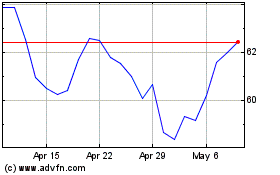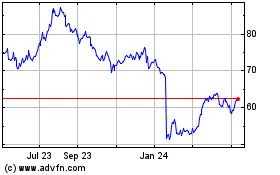U.S. regulators cut annual requirements for how much ethanol
must be mixed into the nation's fuel supply. But the reductions
were smaller than originally proposed, softening the blow to
ethanol companies and their Farm Belt supporters.
The Environmental Protection Agency on Monday said fuel
companies will have to blend 18.11 billion gallons of corn-based
ethanol and other biofuels into gasoline next year, up from the
17.4 billion it proposed in May, but well below targets laid out in
a 2007 law. The EPA also eased rules retroactively for 2014 and
2015.
Ethanol-company shares jumped Monday because the EPA's
reductions were less severe than investors had feared. Shares of
Green Plains Inc., one of the biggest U.S. ethanol processors, rose
5%, while shares of smaller Pacific Ethanol Inc. surged 21%. Stock
in Archer Daniels Midland Co., the biggest U.S. ethanol producer by
capacity, edged up 0.1%, shedding earlier losses after the EPA
numbers were released.
The agency moved to ease the annual biofuels-blending
requirements because of market constraints and other challenges
that it said have kept it from meeting the goals of a federal law
first passed a decade ago.
The renewable-fuel standard, first established by Congress as
part of a 2005 energy law and significantly expanded in 2007, was
designed to help reduce carbon emissions and wean the U.S. off
foreign oil.
But today the U.S. imports much less oil than it did in the
mid-2000s, thanks to a domestic oil-production boom and higher
fuel-economy standards. Americans also are consuming less gasoline
than the 2005 and 2007 laws envisioned. Energy-industry groups have
been harshly critical of the law and the government's
implementation of it, saying the standard burdens companies and
raises fuel prices for consumers.
The law includes a "waiver" provision, which the EPA used to
issue lower amounts than what the law requires, based on multiple
factors, including what the agency described as a lack of
infrastructure to blend biofuels into gasoline.
The EPA on Monday retroactively set the total amount of ethanol
to be blended in 2014 at 16.28 billion gallons, roughly what was
actually produced. For 2015, EPA set the total level at 16.93
billion gallons, close to the estimated production for this
year.
Reaction in the U.S. Farm Belt was mixed. Some leaders in the
ethanol and corn industries applauded the upward revisions to the
EPA's earlier proposal, but expressed disappointment that the
requirements are below those laid out in 2007. For 2016, for
example, the statute level was 22.25 billion gallons.
"The EPA volumes announced today are a move in the right
direction," said Jeff Broin, chief executive of South Dakota-based
Poet LLC, a large ethanol producer. "However, these numbers fall
well short of our capability to provide clean, domestic ethanol to
America's drivers."
Bob Stallman, president of the American Farm Bureau Federation,
a trade group for farmers, said it was disappointed to see the EPA
"move forward with a decision that will stall growth and progress
in renewable fuels."
The Illinois Corn Growers Association, which represents farmers
in the nation's No. 2 corn-producing state after Iowa, said the
EPA's move amounted to a victory for the oil industry and a blow to
farmers. The agency's action comes at a time when net farm income
in the state already is expected to decline 68% from its high in
2013, because of depressed crop prices.
The American Fuel & Petrochemical Manufacturers, an industry
group that represents refiners, applauded the EPA for reducing
blending requirements. But it accused the EPA of bowing to pressure
from the biofuels lobby in making its final decision and said it
believes the RFS program is dysfunctional and should be
repealed.
"Today's rule is further proof that the RFS program is
irreparably broken and that the only solution is for Congress to
repeal it outright," said AFPM President Chet Thompson. "The simple
truth is that 10 years after promulgation of the program, the
advanced biofuels industry still has not delivered on its promise
of commercially viable fuels, and only the corn ethanol and
biodiesel industries benefit from the RFS."
Biofuels have represented about 10% of total gasoline
consumption in the U.S. since 2011, with nearly all of that coming
from corn-based ethanol.
The EPA faced a court-ordered deadline to issue the 2014 and
2015 levels by Monday.
The overall quotas for 2016 go slightly beyond what the oil
industry has coined the "blend wall"—when the amount of ethanol
mandated by EPA exceeds the amount that can be realistically
blended into the gasoline supply.
That limit is pegged by the industry at about 10%. It stems from
factors such as resistance from refineries that would rather blend
their own product of crude oil and car makers' reluctance to issue
warranties for cars that can take more than 10% ethanol blended
into gasoline because of concerns about damage to engines.
"Over time more and more renewable fuels are available to
consumers and that means more available than what people refer to
as the blend wall," said Janet McCabe, the acting assistant
administrator for EPA's Office of Air and Radiation, on a
conference call with reporters.
Alison Sider
Write to Amy Harder at amy.harder@wsj.com and Jesse Newman at
jesse.newman@wsj.com
Subscribe to WSJ: http://online.wsj.com?mod=djnwires
(END) Dow Jones Newswires
November 30, 2015 20:15 ET (01:15 GMT)
Copyright (c) 2015 Dow Jones & Company, Inc.
Archer Daniels Midland (NYSE:ADM)
Historical Stock Chart
From Mar 2024 to Apr 2024

Archer Daniels Midland (NYSE:ADM)
Historical Stock Chart
From Apr 2023 to Apr 2024
